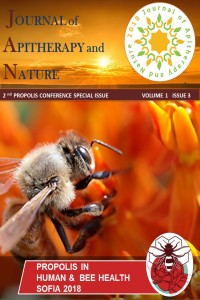Conference Paper
Year 2018,
Volume: 1 Issue: 3 - 2nd Propolis Conference Special Issue, 64 - 64, 08.12.2018
Abstract
Different studies have
reported that propolis have some specific compounds depending on the origin
such as prenylated derivatives of p-coumaric acid in Brazilian propolis.
However, the basic composition is quite similar for all of them, 50 % of
phenolic compounds, 30 % wax, 10 % essential oils and 5 % pollen. Taking it
into account, the aim of this work was to study if it is possible to classify
propolis samples according with their origin on the basis of their phenolic
composition and antioxidant properties determined by standard methods. To do
this, the total contents of flavones and flavonols, flavanones and
dihydroflavonols, and the antioxidant capacity by using the methods of ABTS and
linoleic acid/β-carotene were analysed in 94 samples of propolis from Spain
(Galicia n=14 and Castilla y León n=31 regions) and Chile (Biobio region n=49).
For classification purposes, a multi-layered feed-forward network with
back-propagation was used for predicting the geographical origin of propolis.
The weight, the seed value and bias matrix were randomly initialized. The input
layer had seven neurons (analysed parameters) and seventeen or seven neurons in
the hidden layer. Two (Chile or Spain) or three (Chile, Castilla y León or
Galicia) nominal output variables were used for classification tasks. The
results of the ANN showed that 93.6% of the samples were correctly classified
according with country of origin. However if we wanted to classify the samples
also according the region (Castilla León and Galicia) the number of samples
correctly classified were the 82%.
reported that propolis have some specific compounds depending on the origin
such as prenylated derivatives of p-coumaric acid in Brazilian propolis.
However, the basic composition is quite similar for all of them, 50 % of
phenolic compounds, 30 % wax, 10 % essential oils and 5 % pollen. Taking it
into account, the aim of this work was to study if it is possible to classify
propolis samples according with their origin on the basis of their phenolic
composition and antioxidant properties determined by standard methods. To do
this, the total contents of flavones and flavonols, flavanones and
dihydroflavonols, and the antioxidant capacity by using the methods of ABTS and
linoleic acid/β-carotene were analysed in 94 samples of propolis from Spain
(Galicia n=14 and Castilla y León n=31 regions) and Chile (Biobio region n=49).
For classification purposes, a multi-layered feed-forward network with
back-propagation was used for predicting the geographical origin of propolis.
The weight, the seed value and bias matrix were randomly initialized. The input
layer had seven neurons (analysed parameters) and seventeen or seven neurons in
the hidden layer. Two (Chile or Spain) or three (Chile, Castilla y León or
Galicia) nominal output variables were used for classification tasks. The
results of the ANN showed that 93.6% of the samples were correctly classified
according with country of origin. However if we wanted to classify the samples
also according the region (Castilla León and Galicia) the number of samples
correctly classified were the 82%.
References
- .
Year 2018,
Volume: 1 Issue: 3 - 2nd Propolis Conference Special Issue, 64 - 64, 08.12.2018
Abstract
References
- .
There are 1 citations in total.
Details
| Primary Language | English |
|---|---|
| Journal Section | 2nd Propolis Conference Special Issue |
| Authors | |
| Publication Date | December 8, 2018 |
| Published in Issue | Year 2018 Volume: 1 Issue: 3 - 2nd Propolis Conference Special Issue |
Cite
- Google Akademik (Google Scholar)
- idealonline
- Directory of Research Journal Indexing (DRJI)
- Asos İndeks


